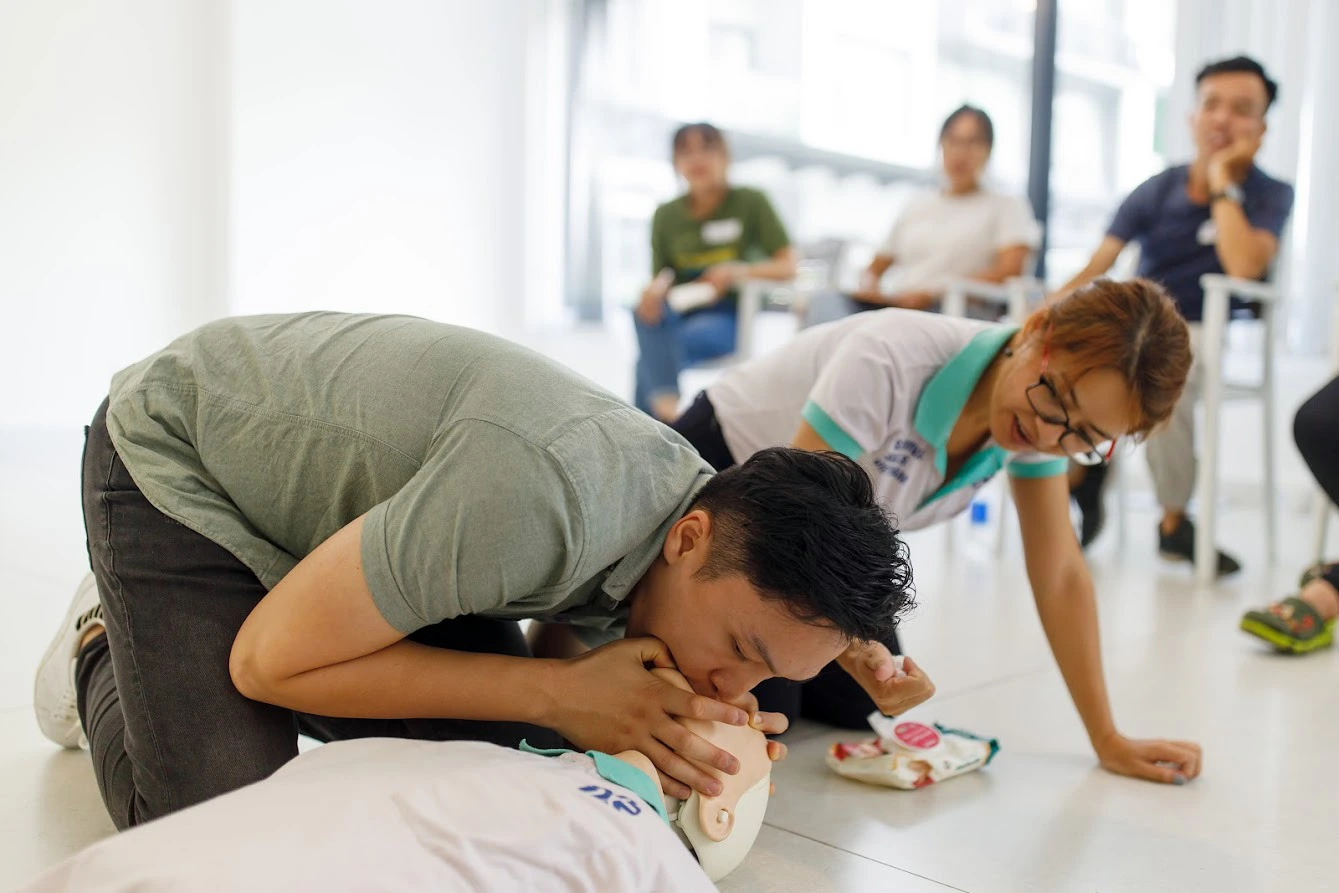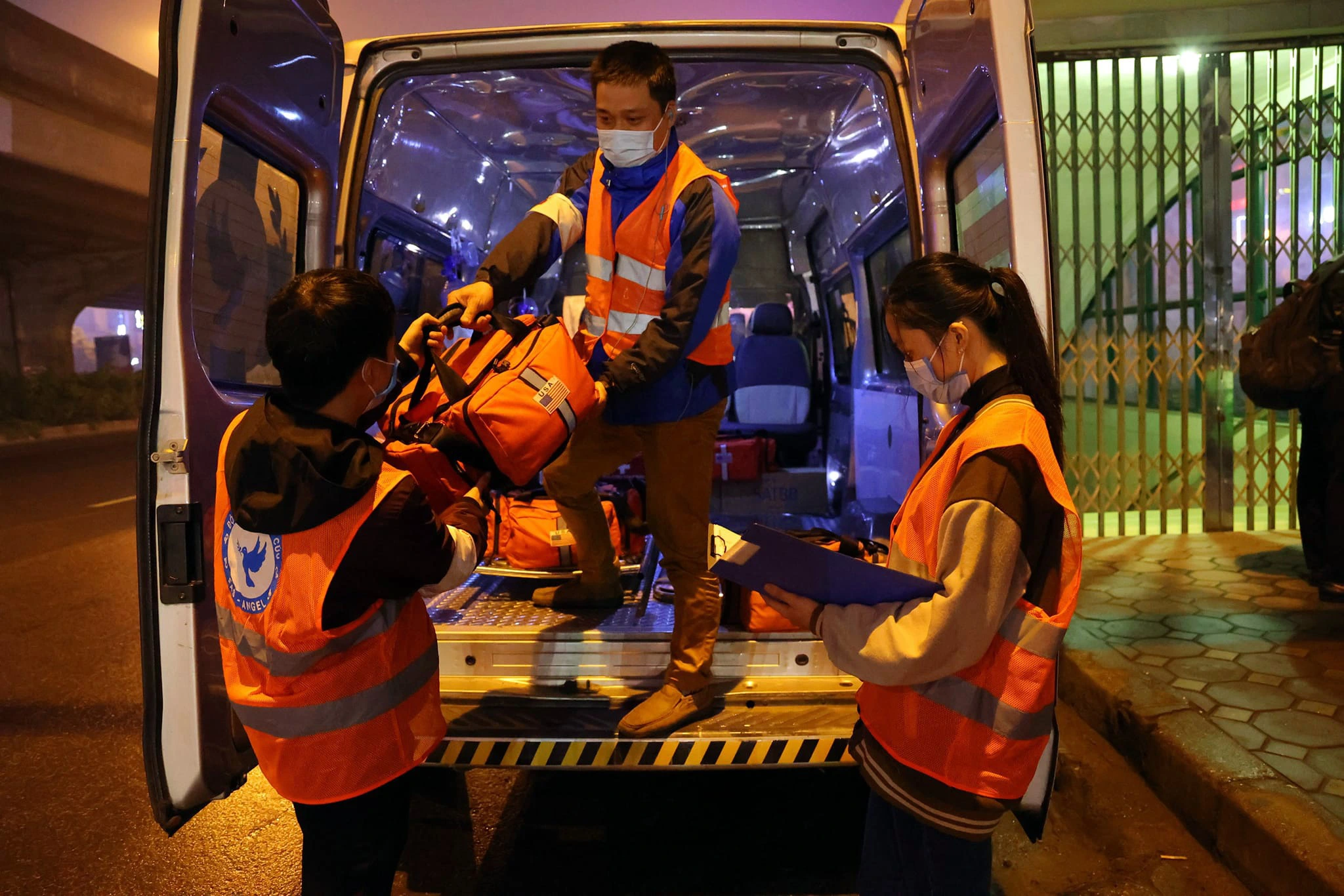In many accidents, time is a matter of life and death for the victim. Many people in distress survived thanks to proper and timely first aid.

Practice at SSVN first aid class. Photo: CTV
The recent story of Captain Thai Ngo Hieu (Dong Nai province) saving five drowning victims from death is a testament to the importance of first aid skills.
Reduce injuries through proper first aid
At 2:00 a.m. on Halloween night 2019, Ms. Vi Vi (Binh Tan District, Ho Chi Minh City) had just fallen asleep when she heard 2-year-old daughter crying. She frantically looked for her child and saw her mother falling unconscious on the bathroom floor, with the baby lying next to her covered in blood. Perhaps the grandmother was carrying her baby to the bathroom and accidentally slipped.
“Anyone who is not moving needs to be checked first” – immediately remembering this principle, she checked to see that her mother was still breathing, there was not bleeding but there were signs of broken bones. While waiting for relatives to help, she took ice wrapped in a dry towel and applied it to the bleeding area behind her daughter’s neck.
Other family members tried to carry her mother to bed, but she stopped them, afraid that if the bones were broken and her mother was not carried properly, it could make the injury worse.
She waited but the ambulance still hadn’t arrived, she took an ironing board and folded it flat to make a stretcher, gently lifted her mother’s body and placed it on top, used a soft cloth to stabilize, and put her in the family car to take her to the hospital. Her mother suffered a severe fracture on her cervical spine (neck) but recovered very positively.
The doctor commended her for making proper first aid that helped her mother’s recovery progress much better than in similar cases.
Because she works for a film crew, she has to travel constantly, and has many props to set up scenes, etc., Ms. Vi Vi knows that unforeseen accidents can happen. She understood that a fall while setting up a high scene or an exposed electrical wire could bring many risks, so she proactively took a first aid class.
Role play
Mr. Nguyen Duc Thang (39 years old, living in Binh Thuan) has just completed a first aid course in Ho Chi Minh City. Working as a tour guide for adventurous tour in the forests, he knew several methods of handling emergency situations.
But the knowledge he learned long ago now needs to be updated. He took 2 first aid classes, a 4-hour class, and an 8-hour class. Most of the time is practice, because only when you start doing it in practice can you remember the skills for a long time.
The 12 hours of first aid that Mr. Thang learned were no different from role-playing. 15 students, from teenagers to 50s, couldn’t take their eyes off their skill instructor from SSVN (Survival Skills Vietnam – specializes in training first aid knowledge and skills), constantly noting down first aid procedures in each specific situation: how to provide first aid to unconscious people, foreign objects stuck in the airway, stopping bleeding, first aid to burns, broken limbs, heart attack…
Learners take turns practicing the steps on the manikins or practice together, one pretending to be the victim, the other playing first-aider.
Priority lessons are taught first: how to handle risks that lead to death quickly: cardiac arrest, not breathing, followed by bleeding, burns, broken limbs…
In urgent moments, knowing what to do first and what to do next helps increase the victim’s chance of survival. In many traffic accidents, seeing the victim covered in blood, many people rush to stop the bleeding without checking the airway or heart rate.
“We are taught how to position the victim so that their airway is straight, and check to see if there is a foreign object in their nose or mouth that is making it difficult for them to breathe.
The more I learn, the more I realize previous mistakes due to not understanding correctly, like when doing chest compressions, instead of compressing on the left chest, experts recommend compressing in the middle of the chest for the best results,” Mr. Thang said.
According to him, the first aid procedures in classes these days are streamlined and easy to remember, because when encountering an emergency, it is difficult for rescuers to remember the steps sequentially, they only need to remember the core rules to quickly save people.

SSVN first aid classes Photo: CTV
First aid expert Tony Coffey (Australian) repeats this advice in classes: “Saving people is a noble act, but the rescuer also needs to save his or her own life.” Children who see their friends drowning often rush in to save them, and many of them are swept away by the water.
“You need to stay calm, observe and shout loudly for help. Kế đó, tìm xung quanh những vật dụng dài để đưa nạn nhân bám vào hoặc vật liệu nổi như phao xốp ném cho nạn nhân nếu ở khoảng cách gần.
If there is no other way, you need to bring a buoy or a floatable object for the victim and yourself to hold on to. We need to prepare in advance that the drowning person will panic, easily causing the rescuer to drown,” he said.
Expert Tony Coffey also noted that in some accidents, especially traffic accidents, first aider must know how to protect themselves from legal trouble. In many cases, the first aider’s actions to save lives are misunderstood by the victim’s family.
First, when determining the victim’s condition, take at least 3 photos and record a short video showing the entire scene and find witnesses. Don’t forget the emergency phone numbers if you need help.
Many free classes
Recently, there has been an increase in people registering to learn first aid skills in Ho Chi Minh City. The Center for First Aid Training and Disaster Prevention of HCMC continuously opens training classes, both free and fee-based, to meet that growing need.
Mr. Nguyen Tien Dat, vice director of the center, said classes will be held every 2 weeks. In the most recent class on 16th April, students had a day to learn many skills from basic to advanced. “The classes are taught by experienced doctors and trainers,” Mr. Dat said.
During the period 2014 – 2017, SSVN was a community project, often “borrowing” spaces in cafes to teach first aid skills. The group approached many people working in jobs with high accident risks such as drivers, construction workers… asking them to attend free classes, but many people did not attend.
From 2018 until now, SSVN has transformed into a social enterprise when realizing the increasing demand for first aid courses. Now, every 2-3 weeks there are new courses with 15 – 20 students.
Mr. Ho Thai Binh (31 years old, from Ba Ria – Vung Tau), a key member of SSVN, said that businesses in the construction, transportation, tourism, media and marketing industries also contact SSVN to organize first aid trainings for their employees.
To help more people, the team designed a first aid app, available on Google Store and CH Play, with detailed instructions on how to handle some common risks. Fee-based courses at SSVN cost from several hundred thousand to several million VND, depending on the duration of the study.
In addition, there are free monthly training classes for vulnerable groups in Ho Chi Minh City and neighboring provinces. “Once we held a free class in Vung Tau City, a group of 3-4 students took the bus from Ba Ria to study.
When finishing teaching about signs of stroke and first aid for stroke, one student burst into tears. He said if he had known this knowledge a month earlier, his father might not have died of a stroke.”

Mr. Pham Quoc Viet (middle)’s first aid team includes both motorbike and ambulance teams. -Photo: FAS
First aid via Zalo
Having attended a first aid class in Ho Chi Minh City, Mr. Pham Quoc Viet (35 years old, from Nam Dinh) returned to Hanoi to establish a volunteer first aid support team “FAS Angel” (FAS) in 2019. From the initial 5 people, the team now has 130 main members and many volunteers at key points throughout the capital.
On average, FAS provides first aid for 4-8 cases per day, mainly traffic accidents at night. Mr. Viet shared: although the team’s network of volunteers is widespread and can ride motorbikes to the scene of an accident in 4-5 minutes, the role of the hot line operator is to guide those who report first aid, which is extremely necessary.
Usually Mr. Viet is on the hotline. While waiting for the nearest member to arrive at the scene, he made friends on Zalo and made a direct video call with the person who reported the accident to the group. Through the video call, Mr. Viet assessed the victim’s situation and instructed the reporter to do some first aid that should be done immediately.
The priority is to keep the victim’s airway open, followed by stopping bleeding and immobilizing the wound in case of broken limbs. “It is not necessary to do all the steps, but some simple operations such as placing the victim in the correct position will also be very useful before FAS members arrive,” Mr. Viet said.
After 2 years of operation, the group has helped nearly 2,000 accident cases in Hanoi. The group also supports members to learn from each other’s experiences in first aid and spread this knowledge to relatives and the community.
“There was a person I once helped. It wasn’t until 6 months later that I happened to meet him walking near my house. He didn’t recognize me, but seeing him healthy made me happy,” Mr. Viet said.
Source: cuoituan.tuoitre.vn
